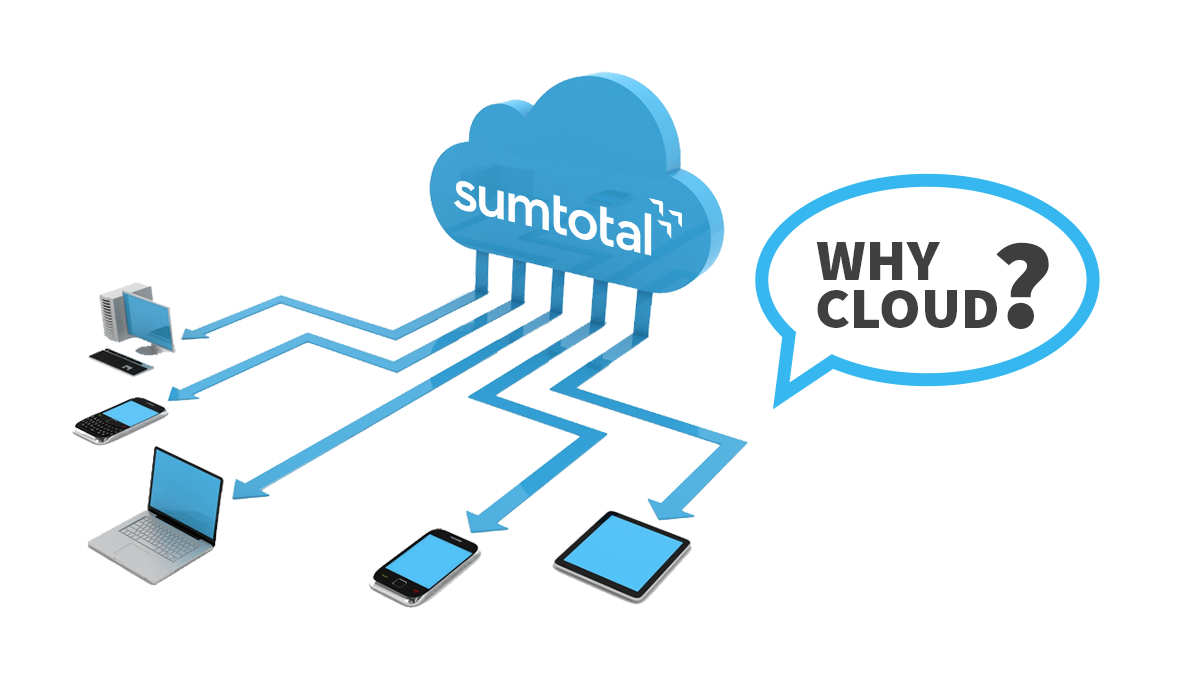
The speed of change in the 21st century requires flexibility, scalability, and technical and social integration. These requirements also apply to learning management platforms. The rapid changes in multi-channel learning delivery, extended enterprise learning, and analytics make an agile learning platform a business necessity.
Cloud deployment of SumTotal Enterprise Learning will help improve your business agility.
Even after several years of widespread use, the word “cloud” still conveys a certain sense of mystery, as though there actually might be a sentient entity somewhere in the ionosphere managing zillions of transactions and vast data repositories.
Awe and wonder might be appropriate for a human endeavor of such scope and consequence, but not mystery. At its most basic, it is many large, secure data centers connected by millions of miles of cables.
Cloud Software Services
When we say “enterprise software in the cloud,” we usually mean the vendor provides the software as a service (SaaS), hosted on servers in one or more connected data centers.
Aside from the rapid deployment models of cloud platform, there are some significant business drivers behind SaaS. Before we get to the pros and cons of the deployment types, let’s review the difference in licensing models and how to assess the costs.
Licensing Models for SumTotal Deployment
There are two primary licensing models for software platforms: a perpetual license and an annual license.
Perpetual license
In a perpetual license, you purchase the right to use the software forever. It is a capital expenditure, and up-front cost is very high. The future license costs include annual maintenance fees and upgrades. Implementation costs are higher than annual licensing.
![]()

Annual License
An annual license is a subscription, where you have right to use the software as long as you pay the fee, often billed monthly. It is an operating expense, not a capital expenditure. What makes the subscription model attractive is that the vendor provides all the servers, infrastructure, applications, updates and patches.
Implementation costs are low, and once you have completed it, you need little or no IT support.
One of the disadvantages of the annual license is that you own nothing but your data. Of course, if service is not satisfactory, you can take your data and go elsewhere and be no worse off.
Over the long term, the cost advantage will disappear. In our opinion, the cost is offset by the benefits of upgrades as the platform improves to keep up with competition and advances in technology.
Why You Should Deploy SumTotal in the Cloud
Quick Deployment. Implementing in the cloud takes weeks, not months or years. Costs are substantially lower.
Scalability. Since SumTotal provides all hardware and infrastructure, it is easy to scale up or down according to changing business needs. It is easier to manage mergers and acquisitions or divestments and spin offs.
Flexibility. Dynamic configuration options make it easier to adapt to changes in your training requirements.
Upgrades. SumTotal provides upgrades automatically or on your schedule, depending on your deployment model.
Lower Infrastructure Costs. Cloud deployment eliminates the need for infrastructure and lifecycle management.
Lower IT Services. Cloud deployment does not require additional IT services for support. Your IT function needs to provide only two services: preparation for data migration and integration, and bandwidth to handle peak loads.
Security. SumTotal provides security equal to on-premises security measures. Economies of scale lower the cost.
SumTotal Deployment Models
Although deployment models can change due to customer needs, SumTotal offers, in general, four deployment options for its enterprise platform.
- Subscription license on public cloud. You have an annual license, and your application and data reside on shared servers.
- Subscription license on private cloud. The application server is shared, but the data server is not.
- Perpetual license on private cloud. Application and data server are on private cloud servers.
- Perpetual license on-premises. Application and data servers are owned and maintained by the customer.
Be a Savvy Buyer
Before you make a decision on your deployment model, know your business requirements and business use cases. Work with an experienced implementation partner who can help you analyze all of the costs and benefits, and consider the flexibility you need to meet future business requirements.
Phenom eCloud is a comprehensive technology solutions provider committed to empowering businesses to overcome challenges, enhance their workforce capabilities, and achieve superior outcome






Leave a Comment